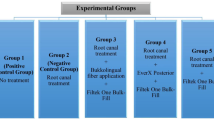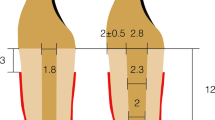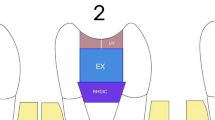Abstract
This study compared fracture resistance of fiber-reinforced and non-fiber-reinforced composite molar crowns under simulated oral stress conditions. Three groups of fiber-reinforced composite crowns were constructed using one polyethylene fiber (belleGlass/Connect) and two glass fiber reinforcement systems (Sculpture/FiberKor, Targis/Vectris). The non-fiber-reinforced crowns based on the facing material alone: Sculpture, Targis or belleGlass. Additionally, crowns were made of the non-reinforced composite Artglass. Each group consisted of eight crowns. All crowns were luted to human molars and exposed to thermal cycling and mechanical loading (6000×5°C/55°C; 1.2×106×50 N; 1.66 Hz). The fracture resistance was measured using a Zwick universal testing machine. Results: The non-reinforced Artglass crowns demonstrated the highest fracture resistance, significantly higher than the resistance shown with belleGlass, belleGlass/Connect or Targis. Artglass showed an extremely wide distribution of values, however. No statistically significant differences were found between the reinforced and non-reinforced composite crowns of Vectris/Targis, FiberKor/Sculpture or Connect/belleGlass although the reinforced crowns showed a tendency towards higher values. The fracture resistance values scattered markedly more for the reinforced crowns, and their lowest fracture values also reached the level of the lowest non-reinforced crowns. The small distribution of fracture values for the non-reinforced crowns indicates that they will be less susceptible for manufacturing faults and more reliable under clinical conditions. Conclusions: Results of this study suggest that single molar composite crowns (tested in this study) do not benefit from fiber-reinforcement.





Similar content being viewed by others
References
Behr M, Hindelang U, Rosentritt M, Lang G, Handel G (2000) Comparison of failure rates of adhesive-fixed partial dentures for in vivo and in vitro studies. Clin Oral Investig 4:25–30
Behr M, Rosentritt M, Lang R, Gröger G, Latzel D, Handel G (2003) Posterior fiber-reinforced fixed partial dentures. A clinical study. Int J Prosthodont 16:239–243
Bohlsen F, Kern M (2002) Clincal outcome of glass-fiber-reinforced crowns and fixed partial dentures. J Dent Res 81:A152
Elias HG (1992) Gefüllte und verstärkte Kunststoffe. Makromoleküle, vol 2, 5th edn Hüthig & Wepf, Basel–
Freilich MA, Karmaker AC, Burstone CJ, Goldberg AJ (1998) Development and clinical applications of a light-polymerized fiber-reinforced composite. J Prosthet Dent 80:311–318
Göhring TN, Schmidlin PR, Imfeld T (2002) Clincal and SEM evaluation of fiber-reinforced composite inlay-FPDs after up to 4 years. J Dent Res 81:A152
Issac DH (1999) Engineering aspects of the structure and properties of polymer-fiber composites. In: Vallittu PK (ed) The First International Symposium on Fiber-Reinforced Plastics in Dentistry 27–29.0.1998, Turku, FIN. University of Turku, Institute of Dentistry and Biomaterials Project, pp I:1–12
Loose M, Rosentritt M, Leibrock A, Behr M, Handel G (1998) In vitro study of fracture resistance and marginal adaptation of fiber-reinforced-composite versus all ceramic fixed partial dentures. Eur J Prosthodont Restor Dent 6:55–62
Menges G, Brintrup H, Batzer H, ed (1984) Verbundwerkstoffe, Polymere Werkstoffe, 2nd edn. Thieme, Stuttgart, pp 494–453
Rosentritt M, Leibrock A, Lang R, Behr M, Handel G (1997) Gerät zur Simulation des Kauorganes (Kausimulator). Materialprüfung 39:77–80
Rosentritt M, Plein T, Kolbeck C, Behr M, Handel G (2000) LCP-In vitro fracture force and marginal adaptation of ceramic crowns fixed on natural and artificial teeth. Int J Prosthodont 13:387–391
Scharnagel P (1998) Simulation der physiologischen Zahnbeweglichkeit bei der in vitro Belastungsprüfung dentaler Restaurationen im "Regensburger Kausimulator." Untersuchung am Beispiel vollkeramischer In-Ceram-Brücken. Thesis, University of Regensburg
Swift EJ, Bryan CC, Boyer DB (1994) Effect of silane-coupling agent on composite repair. Am J Dent 7:200–202
Vallittu PK (1999) Experiences of using glass fibers with multiphase acrylic resin systems. Theoretical background and clinical examples. In: Vallittu PK (ed) The First International Symposium on Fiber-Reinforced Plastics in Dentistry 27–29.08.1998, Turku, FIN. University of Turku, Institute of Dentistry and Biomaterials Project, pp II:1–36
Vankerckhoven H, Lambrechts P, Van Beylen M, Davidson CL, Vanherle G (1982) Unreacted methacrylate groups on the surface of composite resins. J Dent Res 61:791–795
Zanghellini G (1997) Faserverstärkung-die Festigkeit ist eine Funktion des Volumenanteils der Fasern im FRC-Werkstoff. Phillip J 14:390–393
Author information
Authors and Affiliations
Corresponding author
Rights and permissions
About this article
Cite this article
Behr, M., Rosentritt, M., Latzel, D. et al. Fracture resistance of fiber-reinforced vs. non-fiber-reinforced composite molar crowns. Clin Oral Invest 7, 135–139 (2003). https://doi.org/10.1007/s00784-003-0211-x
Received:
Accepted:
Published:
Issue Date:
DOI: https://doi.org/10.1007/s00784-003-0211-x




